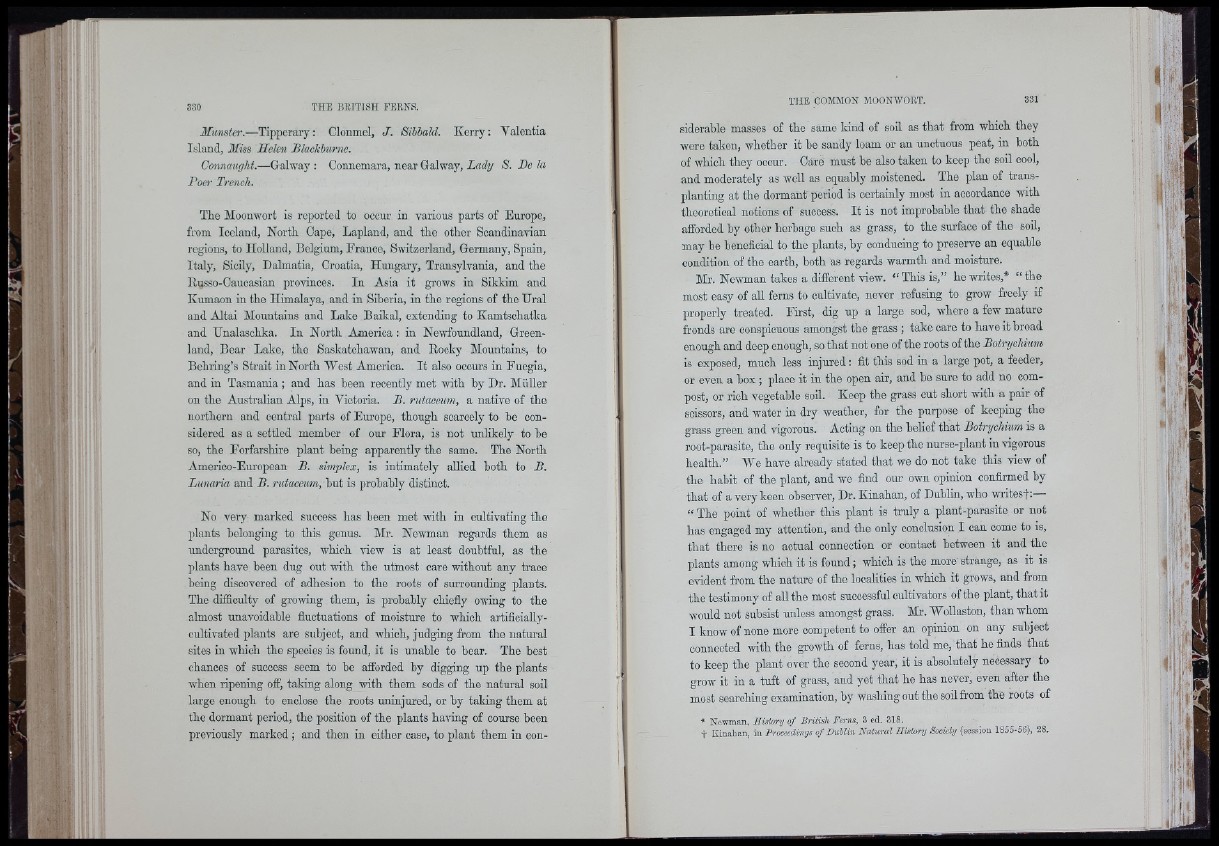
•fi
Munster.—Tipperary: Clonmel, J. Sibbald. Kerry: Valentia
Island, Miss Helen Blackburne.
Connaught.—Galway : Connemara, near Galway, Lady S. Be la
Boor Trench.
The Moonwort is reported to occur in various parts of Europe,
from Iceland, North Cape, Lapland, and the other Scandinavian
regions, to Holland, Belgium, France, Switzerland, Germany, Spain,
Italy, Sicily, Dalmatia, Croatia, Hungary, Transylvania, and the
Husso-Caucasian provinces. In Asia it grows in Sikkim and
Kumaon in the Himalaya, and in Siberia, in the regions of the Hral
and Altai Mountains and Lake Baikal, extending to Kamtschatka
and Unalaschka. In North America: in Newfoundland, Greenland,
Bear Lake, the Saskatohawan, and Eocky Mountains, to
Behring’s Strait in North "West America. It also occurs in Fuegia,
and in Tasmania; and has been recently met with hy Dr. Müller
on the Australian Alps, in Victoria. B. rutaceum, a native of the
northern and central parts of Europe, though scarcely to he considered
as a settled member of our Flora, is not unlikely to he
so, the Forfarshire plant heing apparently the same. The North
Americo-European B. simplex, is intimately allied both to B.
Lunaria and B. rutaceum, but is probably distinot.
No very marked success has been met with in cultivating the
plants belonging to this genus. Mr. Newman regards them as
underground parasites, which view is at least doubtful, as the
plants have been dug out with the utmost care without any trace
being discovered of adhesion to the roots of surrounding plants.
The difficulty of growmg them, is probably chiefly owing to the
almost unavoidable fluctuations of moisture to which artificially-
cultivated plants are subject, and which, judging from the natural
sites in which the species is found, it is unable to hear. The best
chances of success seem to he afforded by digging up the plants
when ripening oif, taldng along with them sods of the natural soil
large enough to enclose the roots uninjured, or by taking them at
the dormant period, the position of the plants having of course been
previously marked; and then in either case, to plant them in con-
.H
siderahle masses of the same kind of soil as that from which they
were taken, whether it be sandy loam or an unctuous peat, in both
of which they occur. Care must be also taken to keep tho soil cool,
and moderately as woll as equably moistened. The plan of transplanting
at the dormant period is certainly most in accordance with
theoretical notions of success. It is not improbable that the shade
afforded by other herbage such as grass, to tho surface of the soil,
may be beneficial to the plants, by coudueing to preserve an equable
condition of the earth, both as regards warmth and moisture.
Mr. Newman takes a different view. “ This is,” he writes,* “ the
most easy of aU ferns to cultivate, never refusing to grow freely if
properly treated. First, dig up a large sod, where a few mature
fronds are conspicuous amongst the grass ; take care to have it broad
enough and deep enough, so that not one of the roots of the Botrychium
is exposed, much less injured: fit this sod in a large pot, a feeder,
or oven a box ; place it in the open air, and he sure to add no compost,
or rich vegetable soil. Keep the grass cut short with a pair of
scissors, and water in dry weather, for the purpose of keeping the
grass greeu and vigorous. Acting on the belief that Botrychium is a
root-parasite, the only requisite is to keep the nurse-plant in vigorous
health.” We have already stated that we do not take this view of
the habit of the plant, and we find our own opinion confirmed hy
that of a very keen observer. Dr. Kinahan, of Dublin, who writesf:—
“ The point of whether this plant is truly a plant-parasite or not
has engaged my attention, and the only conclusion I can come to is,
that there is no actual connection or contact between it and the
plants among which it is found; which is the more strange, as it is
evident from the nature of the localities in which it grows, and from
the testimony of all the most successful cultivators of the plant, that it
would not subsist unless amongst grass. Mr. Wollaston, than whom
I k n o w of none more competent to offer an opinion on any subject
connected with the growth of ferns, has told mo, that he finds that
to keep the plant over the second year, it is absolutely necessary to
grow it in a tuft of grass, and yet that he has never, even after the
most searching examination, by washing out the soil from the roots of
* Newman, History o f British Perns, 3 ed. 318.
+ Kiilalian, in Proceedings o f Dublin Na tu ra l History Society (ses.sion 1855-66), 28.
c \
‘wil
: i'ti
T" '
til
• t t
- f f
lit : I
m